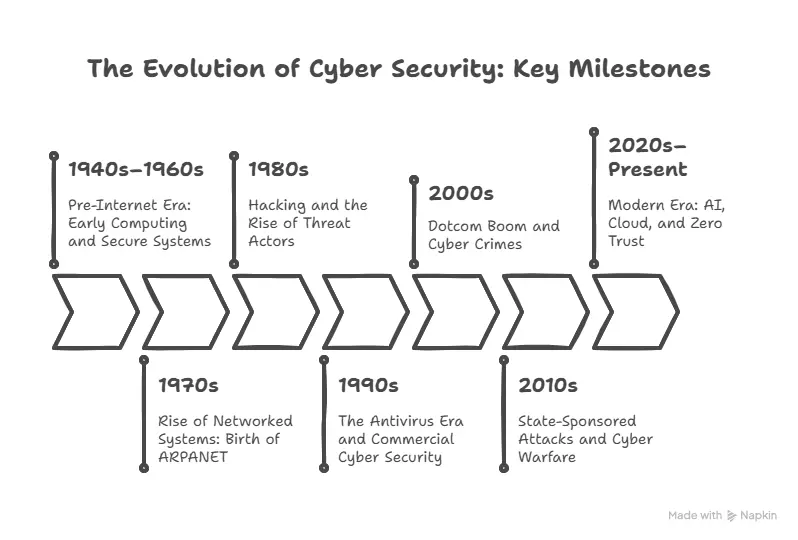History of Cyber Security
Cyber security, as we know it today, is the result of decades of evolution driven by technological advancement, increasing connectivity, and growing threats. From early mainframe systems to the global internet era, the journey of cyber security reflects the battle between innovation and exploitation. This chapter explores the origins, milestones, and transformations in cyber security over the years.

The Pre-Internet Era (1940s–1960s)
a Early Computing and Secure Systems
The concept of securing systems began with the birth of modern computing during World War II.
Machines like ENIAC (Electronic Numerical Integrator and Computer) had no connectivity or need for security, as they were isolated and operated by trusted personnel.
Security by isolation was the de facto strategy.
b. The Cold War Influence
Governments realized the need for secure communications. Cryptography gained importance (e.g., Enigma machine cracked by Alan Turing).
Early focus was more on information security and cryptographic techniques, not on computer security.
The Rise of Networked Systems (1970s)
a. Birth of ARPANET
ARPANET, a precursor to the modern internet, was developed by the U.S. Department of Defense.
First significant realization: when systems are connected, they become vulnerable to unauthorized access.
In 1971, Bob Thomas created “Creeper”, the first self-replicating program (early worm), which led to Ray Tomlinson’s “Reaper”, arguably the first antivirus.
b. Introduction of Multics
Multics (Multiplexed Information and Computing Service) was an early OS that aimed to build a secure system but was criticized for vulnerabilities, prompting studies in secure operating systems.
Hacking and the Rise of Threat Actors (1980s)
a. The Hacker Culture Emerges
Term “hacker” originally referred to clever programmers at MIT, but later evolved to mean unauthorized system breakers.
Early computer clubs like Germany’s Chaos Computer Club (CCC) started exposing system flaws.
b. Notable Incidents
1983: Kevin Poulsen hacked ARPANET.
1986: The Cuckoo’s Egg – a famous case where Clifford Stoll uncovered a spying operation.
c. Legislation and Response
The U.S. passed the Computer Fraud and Abuse Act (CFAA) in 1986 to criminalize unauthorized access.
The Antivirus Era and Commercial Cyber Security (1990s)
a. Malware Boom
Widespread use of Windows and floppy disks helped spread viruses like:
Michelangelo virus
ILOVEYOU
Melissa virus
First-generation antivirus software emerged: McAfee, Norton, AVG.
b. Introduction of Firewalls
Network perimeter security became essential.
First commercial firewall: DEC SEAL (1992).
Packet-filtering and proxy firewalls were introduced to block malicious traffic.
c. Emergence of Professional Cyber Security Industry
Rise of Intrusion Detection Systems (IDS).
Organizations started deploying dedicated IT security teams.
Dotcom Boom and Cyber Crimes (2000s)
a. Worms and Botnets
Code Red (2001) and SQL Slammer (2003) wreaked havoc.
Botnets like Storm and Zeus enabled spam campaigns and banking trojans.
b. Cybercrime Becomes Organized
Hacking moved from hobby to organized crime with financial motives.
Phishing, identity theft, and credit card fraud became common.
c. Legislation and Global Cooperation
EU Cybercrime Convention (2001).
Countries began cooperating on cross-border investigations.
State-Sponsored Attacks and Cyber Warfare (2010s)
a. Advanced Persistent Threats (APTs)
Nation-state actors began using cyber attacks for espionage and sabotage.
Notable APTs:
Stuxnet (U.S.-Israel cyber weapon against Iran’s nuclear program).
APT28/Fancy Bear (Russia).
APT10 (China).
b. Data Breaches and Privacy Concerns
Major breaches affected Yahoo, Equifax, Target, Marriott.
Led to growing concerns around personal data security.
c. Rise of Ransomware
Cybercriminals started encrypting data and demanding ransom (e.g., WannaCry, NotPetya).
Targeted healthcare, governments, and critical infrastructure.
Modern Era: AI, Cloud, and Zero Trust (2020s–Present)
a. Pandemic and Remote Work Shift
COVID-19 led to mass digital adoption.
Increase in VPN attacks, cloud breaches, and video conferencing exploits.
b. Emergence of Zero Trust Architecture
Shift from perimeter security to “Never trust, always verify” models.
Identity and access management (IAM) and multi-factor authentication (MFA) became essential.
c. Artificial Intelligence in Security
AI used in threat detection, behavioral analysis, and automated incident response.
But also misused for deepfakes, AI-driven phishing, and adversarial attacks.
d. Regulations and Frameworks
Rise in compliance frameworks:
GDPR, CCPA
NIST Cybersecurity Framework
ISO/IEC 27001
The history of cyber security is a reflection of the evolving relationship between humans and technology. As connectivity increases, so does the complexity of securing digital assets. From academic curiosity to a trillion-dollar industry, cyber security now plays a pivotal role in national defense, global commerce, and individual privacy. Understanding this evolution is critical for developing proactive and resilient strategies in today’s cyber landscape.
